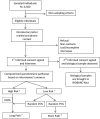Epidemiology and genetics of common mental disorders in the general population: the PEGASUS-Murcia project
- PMID: 24302509
- PMCID: PMC3855565
- DOI: 10.1136/bmjopen-2013-004035
Epidemiology and genetics of common mental disorders in the general population: the PEGASUS-Murcia project
Abstract
Background: Multidisciplinary collaboration between clinicians, epidemiologists, neurogeneticists and statisticians on research projects has been encouraged to improve our knowledge of the complex mechanisms underlying the aetiology and burden of mental disorders. The PEGASUS-Murcia (Psychiatric Enquiry to General Population in Southeast Spain-Murcia) project was designed to assess the prevalence of common mental disorders and to identify the risk and protective factors, and it also included the collection of biological samples to study the gene-environmental interactions in the context of the World Mental Health Survey Initiative.
Methods and analysis: The PEGASUS-Murcia project is a new cross-sectional face-to-face interview survey based on a representative sample of non-institutionalised adults in the Region of Murcia (Mediterranean Southeast, Spain). Trained lay interviewers used the latest version of the computer-assisted personal interview of the Composite International Diagnostic Interview (CIDI 3.0) for use in Spain, specifically adapted for the project. Two biological samples of buccal mucosal epithelium will be collected from each interviewed participant, one for DNA extraction for genomic and epigenomic analyses and the other to obtain mRNA for gene expression quantification. Several quality control procedures will be implemented to assure the highest reliability and validity of the data. This article describes the rationale, sampling methods and questionnaire content as well as the laboratory methodology.
Ethics and dissemination: Informed consent will be obtained from all participants and a Regional Ethics Research Committee has approved the protocol. Results will be disseminated in peer-reviewed publications and presented at the national and the international conferences.
Discussion: Cross-sectional studies, which combine detailed personal information with biological data, offer new and exciting opportunities to study the gene-environmental interactions in the aetiology of common mental disorders in representative samples of the general population. A collaborative multidisciplinary research approach offers the potential to advance our knowledge of the underlying complex interactions and this opens the field for further innovative study designs in psychiatric epidemiology.
Keywords: EPIDEMIOLOGY; GENETICS; MENTAL HEALTH.
Figures

Similar articles
-
Prevalence of Mental Disorders in the South-East of Spain, One of the European Regions Most Affected by the Economic Crisis: The Cross-Sectional PEGASUS-Murcia Project.PLoS One. 2015 Sep 22;10(9):e0137293. doi: 10.1371/journal.pone.0137293. eCollection 2015. PLoS One. 2015. PMID: 26394150 Free PMC article.
-
Post-Traumatic Stress Disorder and other mental disorders in the general population after Lorca's earthquakes, 2011 (Murcia, Spain): A cross-sectional study.PLoS One. 2017 Jul 19;12(7):e0179690. doi: 10.1371/journal.pone.0179690. eCollection 2017. PLoS One. 2017. PMID: 28723949 Free PMC article.
-
Childhood adversities and 5-HTTLPR polymorphism as risk factors of substance use disorders: retrospective case-control study in Murcia (Spain).BMJ Open. 2019 Sep 4;9(9):e030328. doi: 10.1136/bmjopen-2019-030328. BMJ Open. 2019. PMID: 31488488 Free PMC article.
-
[Diagnostic structured interviews in child and adolescent's psychiatry].Encephale. 2004 Mar-Apr;30(2):122-34. doi: 10.1016/s0013-7006(04)95422-x. Encephale. 2004. PMID: 15107714 Review. French.
-
The mental health module (BELLA study) within the German Health Interview and Examination Survey of Children and Adolescents (KiGGS): study design and methods.Eur Child Adolesc Psychiatry. 2008 Dec;17 Suppl 1:10-21. doi: 10.1007/s00787-008-1002-3. Eur Child Adolesc Psychiatry. 2008. PMID: 19132300 Review.
Cited by
-
Childhood adversities and suicidal behavior in the general population. The cross-sectional PEGASUS-Murcia Project.Span J Psychiatry Ment Health. 2024 Jan-Mar;17(1):11-18. doi: 10.1016/j.rpsm.2020.10.002. Epub 2020 Oct 21. Span J Psychiatry Ment Health. 2024. PMID: 33099026 Free PMC article.
-
Gene-environment interactions in severe mental illness.Front Psychiatry. 2014 May 15;5:48. doi: 10.3389/fpsyt.2014.00048. eCollection 2014. Front Psychiatry. 2014. PMID: 24860514 Free PMC article. Review.
-
Activation vs. Experiential Avoidance as a Transdiagnostic Condition of Emotional Distress: An Empirical Study.Front Psychol. 2018 Sep 3;9:1618. doi: 10.3389/fpsyg.2018.01618. eCollection 2018. Front Psychol. 2018. PMID: 30233461 Free PMC article.
-
Modification of the risk of post-traumatic stress disorder (PTSD) by the 5-HTTLPR polymorphisms after Lorca's earthquakes (Murcia, Spain).Psychiatry Res. 2019 Dec;282:112640. doi: 10.1016/j.psychres.2019.112640. Epub 2019 Nov 11. Psychiatry Res. 2019. PMID: 31727442 Free PMC article.
-
Birth-sex cohort alcohol use transitions in the general population: the cross-sectional PEGASUS-Murcia project.Adicciones. 2020 Apr 1;32(2):94-104. doi: 10.20882/adicciones.1067. Adicciones. 2020. PMID: 30627726 Free PMC article.
References
-
- Alonso J, Lepine JP. Overview of key data from the European Study of the Epidemiology of Mental Disorders (ESEMeD). J Clin Psychiatry 2007;68(Suppl 2):3–9 - PubMed
-
- Kessler RC. The World Health Organization International Consortium in Psychiatric Epidemiology (ICPE): initial work and future directions—the NAPE Lecture 1998. Nordic Association for Psychiatric Epidemiology. Acta Psychiatr Scand 1999;99:2–9 - PubMed
Grants and funding
LinkOut - more resources
Full Text Sources
Other Literature Sources
